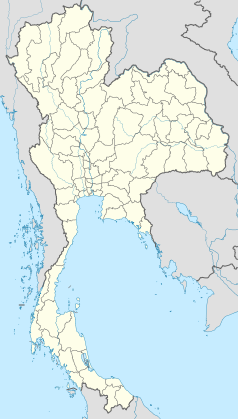Ban Chiang
| ||
| Obiekt z listy światowego dziedzictwa UNESCO | ||
 | ||
| Państwo | ||
| Typ | kulturowy | |
| Spełniane kryterium | III | |
| Numer ref. | 575 | |
| Region[b] | Azja i Pacyfik | |
| Historia wpisania na listę | ||
| Wpisanie na listę | 1992 na 16. sesji | |
Ban Chiang (taj. แหล่งโบราณคดีบ้านเชียง) – stanowisko archeologiczne w północno-wschodniej Tajlandii, w 1992 roku wpisane na listę światowego dziedzictwa UNESCO.
W 1966 roku natrafiono tu na pozostałości osady i cmentarzyska z epoki brązu z IV tysiąclecia p.n.e. Na obszarze wykopalisk odnaleziono gliniane naczynia, pokryte czerwonymi wzorami na żółtym tle, oraz przedmioty z brązu. Metoda obróbki brązu nie wskazuje na wpływy cywilizacji chińskiej, co sugeruje istnienie w Ban Chiang niezależnego ośrodka cywilizacyjnego w IV tysiącleciu p.n.e. Odkrycie to zmieniło pogląd historyków o Azji Południowo-Wschodniej jako o obszarze zacofanym kulturowo w tej epoce.
Galeria
Bibliografia
- Tajlandia, seria: Przewodnik Pascala, Wydawnictwo Pascal, Bielsko-Biała 2005, str. 436
Media użyte na tej stronie
The national flag of Kingdom of Thailand since September 2017; there are total of 3 colours:
- Red represents the blood spilt to protect Thailand’s independence and often more simply described as representing the nation.
- White represents the religion of Buddhism, the predominant religion of the nation
- Blue represents the monarchy of the nation, which is recognised as the centre of Thai hearts.
Flag of the United Nations Educational, Scientific and Cultural Organization (UNESCO)
Bowl with base. Lopburi 2300 BCE. Thailand, Bang Chiang culture. 210-200 BCE. Ceramic, painted. 132 cm. Located in the Museum für Indische Kunst, Berlin-Dahlem.
Autor: User:Mattes, Licencja: CC BY-SA
Wat Pho Si Nai (Ban Chiang Archaeological site, Thailand), UNESCO World Heritage Site.
Autor: PHGCOM, Licencja: CC BY-SA 4.0
Black Ceramic Ban Chiang Culture vase. Thailand 1200-800 BCE.
Autor: Steve from Bangkok, Thailand, Licencja: CC BY-SA 2.0
Ban Chiang Thailand, archeological site in North East Thailand. Unesco World Heritage site. Famous for its red pottery. Civilization that lived in Asia 5,000 years ago, and worked in Bronze. Originally thought to be a backwater area of the world in Asia, bronze metal working emerged at the same time as in the middle east, surprising archeologists. The original Ban Chiang people moved on, migrated or were pushed out of the area 1000 years ago. Today's Thai people migrated down from southern China starting 1,000 years ago. Visiting the Ban Chiang site(s) for a day trip while in North East Thailand can't be missed!
Wikipedia









